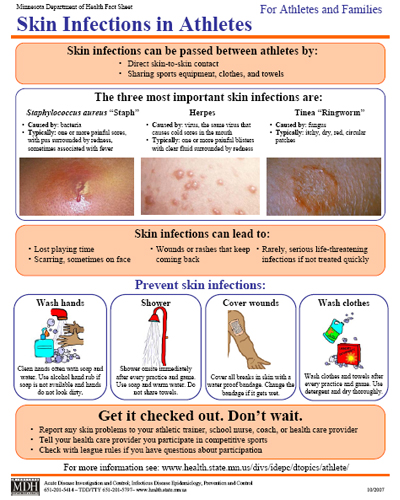Contact Info
Infectious Disease Epidemiology, Prevention and Control Division
651-201-5414
Skin Infections: Information for Athletes and Families
Download a print version of this document:
Skin Infections: Information for Athletes and Families (PDF)

Skin infections can be passed between athletes by:
- Direct skin-to-skin contact
- Sharing sports equipment, clothes, and towels
The three most important skin infections are:
- Staphylococcus aureus “Staph”
Caused by: bacteria
Typically: one or more painful sores, with pus surrounded by redness, sometimes associated with fever
- Herpes
Caused by: virus, the same virus that causes cold sores in the mouth
Typically: one or more painful blisters with clear fluid surrounded by redness
- Tinea “Ringworm”
Caused by: fungus
Typically: itchy, dry, red, circular patches
Skin infections can lead to:
- Lost playing time
- Scarring, sometimes on face
- Wounds or rashes that keep coming back
- Rarely, serious life-threatening infections if not treated quickly
Prevent skin infections:
Wash hands:
- Clean hands often with soap and water. Use alcohol hand rub if soap is not available and hands do not look dirty.
Shower:
- Shower on site immediately after every practice and game. Use soap and warm water. Do not share towels.
Cover wounds:
- Cover all breaks in skin with a water proof bandage. Change the bandage if it gets wet.
Wash clothes:
- Wash clothes and towels after every practice and game. Use detergent and dry thoroughly.
Get it checked out. Don’t wait.
- Report any skin problems to your athletic trainer, school nurse, coach, or health care provider
- Tell your health care provider you participate in competitive sports
- Check with league rules if you have questions about participation
Last Updated: 10/20/2022